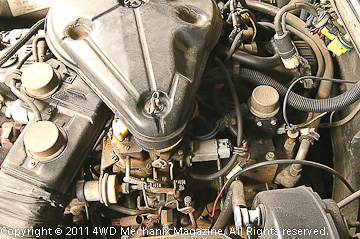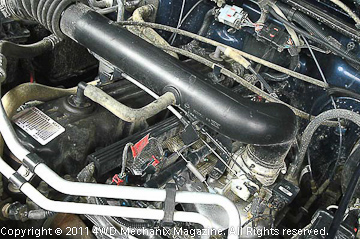Rapid advances in engine fuel-and-spark management span the modern Jeep era. In 1987, the YJ Wrangler 2.5L four became the first Jeep 4×4 utility model with fuel injection. The 2.5L throttle body injected (TBI) engine was a Cherokee offering as well.
Simultaneously, the 1987-90 YJ Wranglers with 4.2L sixes were among the last North American-built Jeep engines to use a carburetor. In 1991, the full-size Grand Wagoneer finished its nearly thirty-year history as the last U.S.-market Jeep to offer carburetion and an AMC-designed V-8 engine.
While the YJ’s 4.2L six was essentially the engine used in AMC-era CJ models, this engine also shared many design features with the XJ Cherokee’s 4.0L inline six introduced in 1987. From 1987-90, the 4.0L six featured a multi-point “Renix” MPI fuel injection system that worked well in this application. As Jeep Corporation launched the 1991 models, Chrysler’s influence would be seen with the introduction of its own 2.5L and 4.0L MPI fuel injection systems for the YJ and XJ models.

The 1987-90 YJ 4.2L inline six cylinder engine carries forth the CJ-era carburetion and induction system. This is a feedback BBD Carter 2-barrel carburetor that works with the MCU (micro-computer unit) and a series of engine sensors. A closed loop design, this is the last generation carburetor. The ignition uses a distributor. Focused on lower tailpipe emissions, these fuel and spark systems were somewhat complex.

The YJ Wrangler launched the first utility Jeep 4×4 with fuel injection. 1987-90 2.5L throttle body injection (TBI) engines provided much needed on- and off-pavement performance gains. EFI quickly proved its versatility on slopes and at altitude. Over-enrichment at higher altitudes is non-existent with EFI, as feedback from the oxygen sensor and manifold absolute pressure (MAP) sensor help adjust injector flow. 1991 2.5L engines featured multi-point fuel injection (MPI) for improved fuel distribution and performance.
Gone was the era of carburetion and also the 4.2L six. In its place were formidable 2.5L MPI four cylinder engines and the powerful MPI 4.0L inline six, a powerplant option that served the YJ Wrangler, XJ Cherokee and the all-new ZJ Grand Cherokee introduced as a 1993 model. These proven 2.5L and 4.0L MPI engines also launched the TJ Wrangler in 1997. 2.5L and 4.0L engines served the XJ Cherokee through its last model year (2001). 4.0L sixes remained the base engine for the 1999-2004 WJ Grand Cherokee and served as the more powerful engine option for all TJ Wranglers.
The strength and ruggedness of these engines are indisputable. By design, the only deficit of the carbureted 4.2L six was its continued use of carburetion. In an era of emission system constraints, the 4.2L paid significantly for its clean tailpipe.
Use of electronic fuel injection could easily have kept this long-stroke, stump pulling six in the Jeep lineup. Proof of the 4.2L six’s ability to run stronger and cleaner is the retrofit of a Mopar Performance 50-State legal MPI induction system on a 4.2L engine in good condition. Tailpipe emissions drop to levels rivaling the 4.0L engine, and horsepower increases—often 50 or more—with no other engine modifications.
While throttle body EFI was a major breakthrough for the 2.5L engine, the switch to multi-point, port fuel injection provides a significant gain for any inline engine. Inherently, inline engines, especially six-cylinder types, do not respond well to a single carburetor and long intake plenum runners. The Jeep 232/258 (4.2L) six suffers significantly from this phenomenon. A carburetor mounted mid-manifold cannot distribute fuel uniformly to the outer cylinders.
Throttle body injection, which does deliver improved fuel efficiency and lower tailpipe emissions, does not solve the plenum runner length issue. In fact, a TBI unit and use of a single oxygen sensor at the exhaust manifold collector can still cause lean burning on outer cylinders.
The YJ Wrangler sixes needed multi-point, port fuel injection, and Chrysler responded with the 1991-up MPI 4.0L engines. Port injection provides optimal, uniform air/fuel ratios per cylinder and maximum performance with cleaner emissions.
In this section of the magazine, I begin with carburetion system needs that apply only to the 4.2L inline sixes. You will also find steps and full details on installing the Mopar 50-State legal 4.2L MPI conversion. That induction system is patterned after 4.0L original equipment components and serves as an excellent prototype for illustrating the layout and function of Jeep 4.0L fuel-and-spark management systems. Jeep 4.0L models with distributor-type ignitions share similar service steps. These also apply to the 2.5L MPI four-cylinder engine.
Note—Newer “distributorless” Jeep engines do not require the routine distributor cap, rotor and spark plug wire replacement. Otherwise, the distributorless MPI systems have needs and components much like earlier Chrysler MPI systems.

1991-up Jeep Wrangler 4.0L and 2.5L models share the added benefits of multi-point fuel injection. MPI gives long inline engines the uniform fuel distribution that will maximize performance yet maintain the lowest possible tailpipe emissions. Both the 2.5L and 4.0L engines benefit from Chrysler’s MPI system, illustrated here on a TJ 4.0L engine. MPI brought out the true performance potential of the 4.0L engine. The Mopar Performance retrofit MPI package is a major gain for early YJ Wrangler 4.2L sixes.
I also share fundamental troubleshooting guidelines for the 2.5L TBI four-cylinder engine, an engine available in the early XJ Cherokee and YJ Wrangler. The TBI owner will find basic tuning and field troubleshooting are well within reach. These are reliable systems with basic components.
The 1987 YJ 2.5L four depicted in these articles had 203,000 miles on its odometer with nearly all of its original components still in place and reliable. Many parts and tuning components for early XJ and YJ models are still available from Mopar as well as aftermarket sources.
I have also included details on the distributorless fuel and spark management systems that power up the later 2.4L and 4.0L Jeep engines. These components serve throughout the Jeep vehicle lines and represent state-of-the-art systems. There are addition sensors on the distributorless engines that enable the on-board OBD-II diagnostics system to pinpoint trouble spots and even signal significant internal engine parts wear.
OBD-II and special scan tools help us perform advanced diagnostics and troubleshooting. The on-board programming also provides the Jeep dealership with the ability to “flash” the on-board computer with approved and emission legal updates of software for tuning and improved functions.
At today’s Jeep dealership, a technical service bulletin (TSB) is often the call for a simple re-flash or reloading of updated software. Today’s engine “tuning,” for the most part, is an update of on-board software.
For those new to modern fuel-and-spark management, these articles provide a learning tool for understanding the systems. Most fixes, especially in the field, are not complicated. It is infrequent that the powertrain control module (PCM or computer) fails. Electronic problems are more often related to sensors that fail to provide the right signals—or even something as simple as a loose connection, vacuum hose or faulting, low voltage signal caused by dirty battery connections!
I begin with the fundamental carburetion and conventional ignition of the 4.2L engine. Here, fuel-and-spark management represents the more primitive functions of a feedback carburetor and an MCU (micro-computer unit). Yes, even the carbureted YJ has a computer that to some degree controls fuel flow while also playing a limited role around ignition spark timing.
By understanding the needs of a basic fuel system and ignition, owners of modern Jeep vehicles will find the TBI and MPI systems easier to troubleshoot and diagnose. The TJ 4.2L six provides a good training ground for learning the basic fuel and spark needs of an engine.
